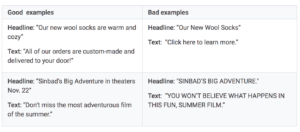Tips for Creating Effective Display Ads
According to Google, Display Network sites reach over 90% of internet users worldwide. This presents a great opportunity to gain significant visibility for brands. Display ads have considerable potential, but to be effective they must be created correctly. When a display campaign is executed in the wrong way, marketers put themselves at risk of wasting large amounts of ad dollars. If you’re new to display ads or looking to improve performance, here are 5 tips for creating effective display ads.
1. Use Rich Media
Rich media helps engage consumers. This can be done with video, audio, or any element that encourages users to interact with the ad. One of the easiest ways to accomplish this is with HTML5 ads. HTML5 ads enable animation, and interactive content, but are also responsive/adaptive, meaning that your design will look good across any browser, OS, or device. These ads can be created easily inside of Google Web Designer. Rich media allows for your ads to stand out and has been proved to grab users’ attention. EMarketer research shows that brands experience higher levels of engagement (16.2%) using rich media ads compared to static banners.
2. Use Responsive Ads
Using responsive ads ensures you’re making it as easy as possible for your ads to be shown across the Display Network. Using responsive ads saves you time creating different versions of your ads for different devices. Responsive ads will automatically adjust the size of your ad for different types of devices, such as mobile, tablet and desktops, and can fit in almost any available ad space. They can also be used with dynamic remarketing. This is done by attaching a feed to your campaigns. Responsive ads then show personalized content to users from the feed you control.
3. Use Clear and Compelling Headlines, Ad Copy, and CTA’s
For best results, your headline should be clear, simple, and describe your offering or brand. Avoid generic or click-bait messaging and using all caps. Your description should be easy to understand and make it clear why it’s worth clicking on. Creating a strong call-to-action is always essential when creating an effective ad. Marketers have to tell users what they should do following clicking on the ad. This can be extremely simple, such as “sign up now” or “request a quote today.” Google gives examples of best and worst practices when it comes to headlines and text.

Source: https://support.google.com/google-ads/answer/1722134?hl=en
4. Provide a Relevant Landing Page
One of the biggest mistakes a marketer can make when creating any type of campaign is sending users to their homepage or an irrelevant landing page. If a user goes as far as to click on your ad, you don’t want to send them to a page where they then have to further search for the information they expect to find. Your CTA should take users straight to a page associated with what you ultimately want them to do. For example, if your ad text says “Call us,” be sure to include your business phone number on the landing page. If your ad text says “Limited time offer,” be sure to point people to that promotion on the landing page.
5. Create Multiple Ads per Ad Group
Best practice involves testing out multiple ad variations. Google suggests creating 3 to 4 ads per ad group, trying out different messages and different images to see which perform best with your target audience. With Google Ads it will immediately show which ads are better performing for which group, but it’s best to run the tests long enough to get the most accurate data.
Conclusion
Rates per click are generally lower on the Display Network. Which is why to produce high performing display ads, you need to incorporate all of the features above, and then some. Creating successful display campaigns may take some extra work, but the results are worth it. If you need assistance with creating display ads, or in any area of Google Ads, allow Onimod Global to help! We are a trusted Google Partner and specialize in search, mobile, video, display, and shopping advertising.
Take a look at how we’ve helped other companies, learn more about what we can do for you, and become a client today.










